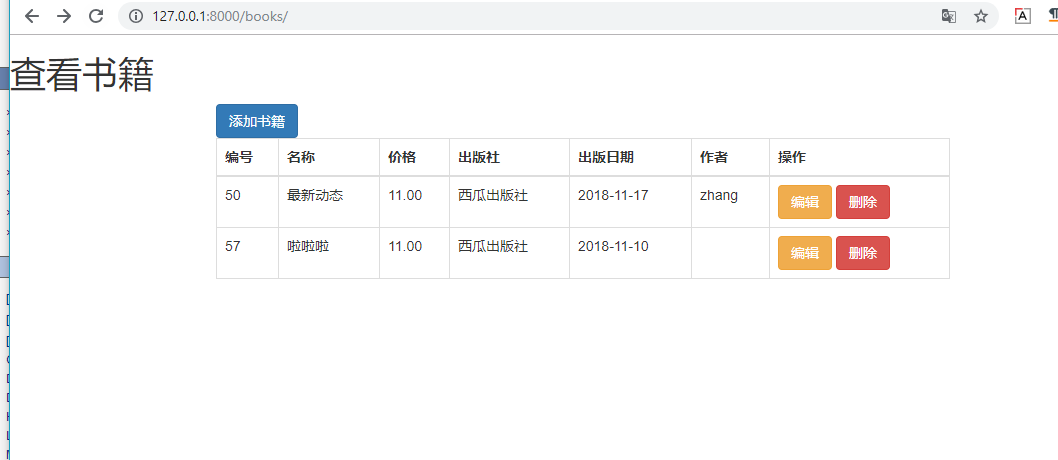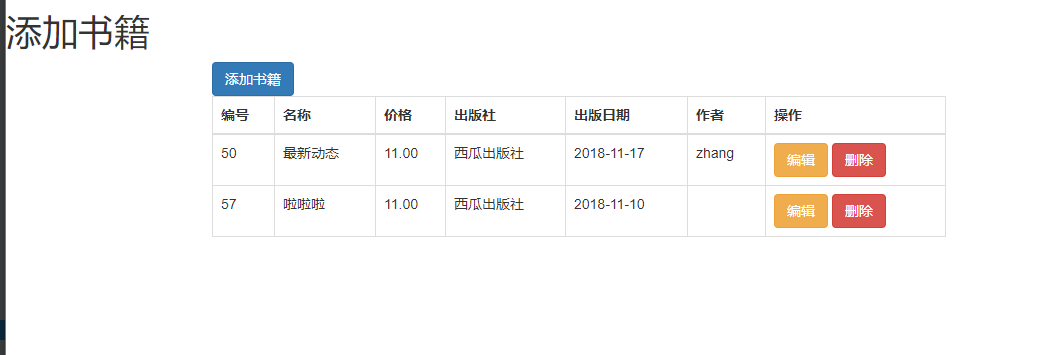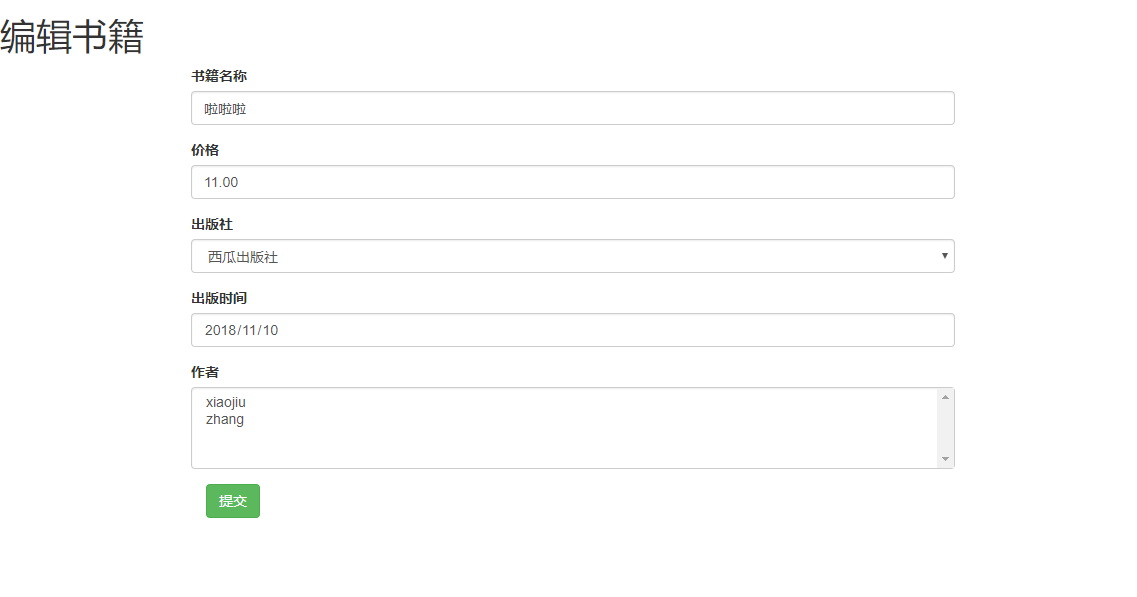Django(图书管理系统)
图书管理系统
注意事项
1、models 要创建好,规划好自己的表,以及各种表关系
2、url正则要写好
3、settings的配置
4、利用bootstarp 进行布局更漂亮哦
5、注意orm 各种类型的转换还有取值。
6、模板语法
下面上菜
目录结构
G:.
├─.idea
│ ├─dataSources
│ └─inspectionProfiles
├─app01
│ ├─migrations
│ │ └─__pycache__
│ ├─static
│ │ └─css
│ └─__pycache__
├─books
│ └─__pycache__
└─templates
项目代码
settings.py
"""
Django settings for books project. Generated by 'django-admin startproject' using Django 2.0.2. For more information on this file, see
https://docs.djangoproject.com/en/2.0/topics/settings/ For the full list of settings and their values, see
https://docs.djangoproject.com/en/2.0/ref/settings/
""" import os # Build paths inside the project like this: os.path.join(BASE_DIR, ...)
BASE_DIR = os.path.dirname(os.path.dirname(os.path.abspath(__file__))) # Quick-start development settings - unsuitable for production
# See https://docs.djangoproject.com/en/2.0/howto/deployment/checklist/ # SECURITY WARNING: keep the secret key used in production secret!
SECRET_KEY = 'm-zu@pls$#8)6njw1ar5#t#tx#fcfhe7(iaygkg(y4l^x@!!ix' # SECURITY WARNING: don't run with debug turned on in production!
DEBUG = True ALLOWED_HOSTS = [] # Application definition INSTALLED_APPS = [
'django.contrib.admin',
'django.contrib.auth',
'django.contrib.contenttypes',
'django.contrib.sessions',
'django.contrib.messages',
'django.contrib.staticfiles',
'app01.apps.App01Config',
] MIDDLEWARE = [
'django.middleware.security.SecurityMiddleware',
'django.contrib.sessions.middleware.SessionMiddleware',
'django.middleware.common.CommonMiddleware',
'django.middleware.csrf.CsrfViewMiddleware',
'django.contrib.auth.middleware.AuthenticationMiddleware',
'django.contrib.messages.middleware.MessageMiddleware',
'django.middleware.clickjacking.XFrameOptionsMiddleware',
] ROOT_URLCONF = 'books.urls' TEMPLATES = [
{
'BACKEND': 'django.template.backends.django.DjangoTemplates',
'DIRS': [os.path.join(BASE_DIR, 'templates')]
,
'APP_DIRS': True,
'OPTIONS': {
'context_processors': [
'django.template.context_processors.debug',
'django.template.context_processors.request',
'django.contrib.auth.context_processors.auth',
'django.contrib.messages.context_processors.messages',
],
},
},
] WSGI_APPLICATION = 'books.wsgi.application' # Database
# https://docs.djangoproject.com/en/2.0/ref/settings/#databases # DATABASES = {
# 'default': {
# 'ENGINE': 'django.db.backends.sqlite3',
# 'NAME': os.path.join(BASE_DIR, 'db.sqlite3'),
# }
# } DATABASES = {
'default': {
'ENGINE': 'django.db.backends.mysql',
'NAME': 'books',
'HOST': '172.16.0.30',
'PORT': '3306',
'USER': 'root',
'PASSWORD': 'zabbix',
}
} # Password validation
# https://docs.djangoproject.com/en/2.0/ref/settings/#auth-password-validators AUTH_PASSWORD_VALIDATORS = [
{
'NAME': 'django.contrib.auth.password_validation.UserAttributeSimilarityValidator',
},
{
'NAME': 'django.contrib.auth.password_validation.MinimumLengthValidator',
},
{
'NAME': 'django.contrib.auth.password_validation.CommonPasswordValidator',
},
{
'NAME': 'django.contrib.auth.password_validation.NumericPasswordValidator',
},
] # Internationalization
# https://docs.djangoproject.com/en/2.0/topics/i18n/ LANGUAGE_CODE = 'en-us' TIME_ZONE = 'UTC' USE_I18N = True USE_L10N = True USE_TZ = True # Static files (CSS, JavaScript, Images)
# https://docs.djangoproject.com/en/2.0/howto/static-files/ STATIC_URL = '/static/'
LOGGING = {
'version': 1,
'disable_existing_loggers': False,
'handlers': {
'console': {
'level': 'DEBUG',
'class': 'logging.StreamHandler',
},
},
'loggers': {
'django.db.backends': {
'handlers': ['console'],
'propagate': True,
'level': 'DEBUG',
},
}
}
urls.py
"""books URL Configuration The `urlpatterns` list routes URLs to views. For more information please see:
https://docs.djangoproject.com/en/2.0/topics/http/urls/
Examples:
Function views
1. Add an import: from my_app import views
2. Add a URL to urlpatterns: path('', views.home, name='home')
Class-based views
1. Add an import: from other_app.views import Home
2. Add a URL to urlpatterns: path('', Home.as_view(), name='home')
Including another URLconf
1. Import the include() function: from django.urls import include, path
2. Add a URL to urlpatterns: path('blog/', include('blog.urls'))
"""
from django.contrib import admin
from django.urls import path
from app01 import views
from django.conf.urls import url urlpatterns = [
path('admin/', admin.site.urls),
path('index', views.index),
url(r'^editbooks/(?P<nid>[0-9]*)/edit$', views.editbooks, name='editbooks'),
url(r'^books/(?P<nid>[0-9]*)/delete$', views.delete, name='delete'),
url(r'^books/$', views.books),
url(r'^addbooks/', views.addbooks, name='addbooks'), ]
views.py
from django.shortcuts import HttpResponse, render, redirect, HttpResponseRedirect
from .models import *
import decimal
from django.db.models import Avg, Sum, Count, Max, Min, F, Q def index(request):
return HttpResponse('ok') def books(request):
book_list = Book.objects.all()
author_list = Author.objects.all()
publish_list = Publish.objects.all() return render(request, 'books.html', {'book_list': book_list, 'author': author_list, 'publish_list': publish_list}) def delete(request, nid):
book_obj = Book.objects
print('_________________________________________________________')
print(nid)
book_obj.filter(nid=nid).delete()
print('删除成功')
return redirect('/books') def addbooks(request):
author_list = Author.objects.all()
publish_list = Publish.objects.all()
if request.method == 'GET':
return render(request, 'addbooks.html', {'publish_list': publish_list, 'author_list': author_list})
else:
try:
title = request.POST.get('title')
price = int(request.POST.get('price'))
pub_date = request.POST.get('pub_date')
publish_id = request.POST.get('publish_id')
autho_id_list = request.POST.getlist('author_id_list') # 当获取多个数值的时候,使用getlist
book_obj = Book.objects.create(title=title, price=price, publishDate=pub_date, publish_id=publish_id)
book_obj.authors.add(*autho_id_list)
except Exception as e:
print(e, '数值郭达')
return redirect('/addbooks')
return redirect('/books') def editbooks(request, nid):
author_list = Author.objects.all()
publish_list = Publish.objects.all()
book_nid_obj = Book.objects.get(nid=nid)
if request.method == 'GET':
return render(request, 'editbooks.html',
{'author_list': author_list, 'book_nid_obj': book_nid_obj,
'publish_list': publish_list}) else:
# 编辑操作
title = request.POST.get('title')
price = int(request.POST.get('price'))
pub_date = request.POST.get('pub_date')
publish_id = request.POST.get('publish_id')
author_id_list = request.POST.getlist('author_id_list') # 当获取多个数值的时候,使用getlist
print(request.POST) book_obj_ed = Book.objects.filter(nid=nid)
print(book_nid_obj) # Book 对象
print('--------------------------------------------')
print(book_obj_ed) # QueySet
book_obj_ed.update(title=title, price=price, publishDate=pub_date, publish_id=publish_id)
book_nid_obj.authors.clear()
book_nid_obj.authors.add(*author_id_list)
return redirect('/books')
models.py
from django.db import models # Create your models here. class Author(models.Model):
nid = models.AutoField(primary_key=True)
name = models.CharField(max_length=32)
age = models.IntegerField() # 与AuthorDetail建立一对一的关系
authorDetail = models.OneToOneField(to="AuthorDetail", on_delete=models.CASCADE) class AuthorDetail(models.Model):
nid = models.AutoField(primary_key=True)
birthday = models.DateField()
telephone = models.BigIntegerField()
addr = models.CharField(max_length=64) class Publish(models.Model):
nid = models.AutoField(primary_key=True)
name = models.CharField(max_length=32)
city = models.CharField(max_length=32)
email = models.EmailField() class Book(models.Model):
nid = models.AutoField(primary_key=True)
title = models.CharField(max_length=32)
publishDate = models.DateField()
price = models.DecimalField(max_digits=5, decimal_places=2) # 与Publish建立一对多的关系,外键字段建立在多的一方
publish = models.ForeignKey(to="Publish", to_field="nid", on_delete=models.CASCADE)
# 与Author表建立多对多的关系,ManyToManyField可以建在两个模型中的任意一个,自动创建第三张表
authors = models.ManyToManyField(to='Author', )
templates
books.html
<!DOCTYPE html>
<html lang="en">
<head>
<meta charset="UTF-8">
<title>图书管理系统</title>
</head>
{% load staticfiles %}
<link rel="stylesheet" href="https://cdn.jsdelivr.net/npm/bootstrap@3.3.7/dist/css/bootstrap.min.css"
integrity="sha384-BVYiiSIFeK1dGmJRAkycuHAHRg32OmUcww7on3RYdg4Va+PmSTsz/K68vbdEjh4u" crossorigin="anonymous">
<body>
<h1>添加书籍</h1>
<div class="col-md-8 col-md-offset-2 " >
<a class="btn btn-primary" href="{% url 'addbooks' %}"> 添加书籍</a>
<table class="table table_striped table-bordered table-hover">
<thead>
<tr>
<th>编号</th>
<th>名称</th>
<th>价格</th>
<th>出版社</th>
<th>出版日期</th>
<th>作者</th>
<th>操作</th>
</tr>
</thead>
<tbody>
{% for book in book_list %}
<tr>
<td>{{ book.nid }}</td>
<td>{{ book.title }}</td>
<td>{{ book.price }}</td>
<td>{{ book.publish.name }}</td>
<td>{{ book.publishDate | date:'Y-m-d'}}</td>
<td>
{% for auth in book.authors.all.values %}
{% if forloop.last %}
<span>{{ auth.name }} </span>
{% else %}
<span>{{ auth.name }} ,</span>
{% endif %}
{% endfor %}
</td>
<td>
<a class=" btn btn-warning data-toggle='button" href="{% url 'editbooks' book.nid %}">编辑
</a>
<a type="button" class="btn btn-danger data-toggle='button"
href="{% url 'delete' book.nid %}">删除</a>
</td> </tr>
{% endfor %}
</tbody> </table>
</div> <script src="https://cdn.jsdelivr.net/npm/jquery@1.12.4/dist/jquery.min.js"></script>
<!-- 加载 Bootstrap 的所有 JavaScript 插件。你也可以根据需要只加载单个插件。 -->
<script src="https://cdn.jsdelivr.net/npm/bootstrap@3.3.7/dist/js/bootstrap.min.js"></script>
</body>
</html>
addbooks.html
<!DOCTYPE html>
<html lang="en">
<head>
<meta charset="UTF-8">
<title>添加书籍</title>
</head>
{% load staticfiles %}
<link rel="stylesheet" href="https://cdn.jsdelivr.net/npm/bootstrap@3.3.7/dist/css/bootstrap.min.css"
integrity="sha384-BVYiiSIFeK1dGmJRAkycuHAHRg32OmUcww7on3RYdg4Va+PmSTsz/K68vbdEjh4u" crossorigin="anonymous">
<body>
<h1>添加书籍</h1>
<div class="col-md-8 col-md-offset-2 "> <form class="form-horizontal" role="form" method="post" action="">
{% csrf_token %}
<div class="form-group">
<label>书籍名称</label>
<input type="text" class="form-control" name="title" placeholder="书籍名称">
</div>
<div class="form-group">
<label>价格</label>
<input type="text" class="form-control" name="price" placeholder="价格">
</div>
<div class="form-group">
<label for="">出版社</label>
<select class="form-control" name="publish_id">
{% for publish in publish_list %}
<option value="{{ publish.pk }}">{{ publish.name }}</option>
{% endfor %}
</select>
</div>
<div class="form-group">
<label>出版时间</label>
<input type="date" class="form-control" name="pub_date" placeholder="出版时间">
</div>
<div class="form-group">
<label for="">作者</label>
<select multiple class="form-control" name="author_id_list">
{% for author in author_list %}
<option value="{{ author.pk }}">{{ author.name }}</option>
{% endfor %}
</select>
</div>
<input class="btn btn-success data-toggle='button" formmethod="post" type="submit">
</form>
</div> </body>
</html>
editbooks.html
<!DOCTYPE html>
<html lang="en">
<head>
<meta charset="UTF-8">
<title>编辑书籍</title>
</head>
{% load staticfiles %}
<link rel="stylesheet" href="https://cdn.jsdelivr.net/npm/bootstrap@3.3.7/dist/css/bootstrap.min.css"
integrity="sha384-BVYiiSIFeK1dGmJRAkycuHAHRg32OmUcww7on3RYdg4Va+PmSTsz/K68vbdEjh4u" crossorigin="anonymous">
<body>
<h1>编辑书籍</h1>
<div class="col-md-8 col-md-offset-2 "> <form class="form-horizontal" role="form" method="post" action="">
{% csrf_token %}
<div class="form-group">
<label>书籍名称</label>
<input type="text" class="form-control" value="{{ book_nid_obj.title }}" name="title" placeholder="书籍名称">
</div>
<div class="form-group">
<label>价格</label>
<input type="text" class="form-control" value="{{ book_nid_obj.price }}" name="price" placeholder="价格">
</div>
<div class="form-group">
<label for="">出版社</label>
<select class="form-control" name="publish_id">
{% for publish in publish_list %}
<option value="{{ publish.pk }}">{{ publish.name }}</option>
{% endfor %}
</select>
</div>
<div class="form-group">
<label>出版时间</label>
<input type="date" class="form-control" name="pub_date" value="{{ book_nid_obj.publishDate | date:'Y-m-d' }}"
placeholder="出版时间">
</div>
<div class="form-group">
<label for="">作者</label>
<select multiple class="form-control" name="author_id_list">
{% for author in author_list %}
<option value="{{ author.pk }}">{{ author.name }}</option>
{% endfor %}
</select>
</div>
<input class="btn btn-success data-toggle='button" formmethod="post" type="submit">
</form>
</div>
</body>
</html>
页面效果



其他功能等我学会了再来
Django(图书管理系统)的更多相关文章
- Django——图书管理系统
基于Django的图书管理系统 1.主体功能 1.列出图书列表.出版社列表.作者列表 2.点击作者,会列出其出版的图书列表 3.点击出版社,会列出旗下图书列表 4.可以创建.修改.删除 图书.作者.出 ...
- Django(图书管理系统1)
day63 内容回顾 1. 单表的增删改查 1. 删和改 1. GET请求 URL传值 1. 格式 ...
- Django图书管理系统(前端对数据库的增删改查)
图书管理系统 出版社的管理 源码位置:https://gitee.com/machangwei-8/learning_materials/tree/master/%E9%A1%B9%E7%9B%AE/ ...
- django 图书管理系统
一.图书管理系统 单表的增删改查 1.创建项目 2.注释掉中间件 就可以提交post 请求 3.配置静态文件 并手动创建static 文件夹存放静态文件 二.具体的数据库配置 1.创建数据库 2. ...
- Django图书管理系统(前端对有外键的数据表增删改查)
图书管理 书籍管理 book name 项目源码位置:https://gitee.com/machangwei-8/learning_materials/tree/master/%E9%A1%B9%E ...
- django图书管理系统实例
首页,其他页面全部继承首页的上半部分 点击发布图书页面 首页点击书名,跳转到图书信息界面,该界面可删除图书 项目结构 #views.py from django.shortcuts import re ...
- Django(图书管理系统2)
day64 内容回顾 1. ORM外键操作 图书表和出版社表 多对一 的关系 # 书 class Book(models.Model): ...
- Django图书管理系统(单表操作)
以下内容需要掌握: Python3 以及前端:HTML,CSS,jQuery,BootStrap,Django,JavaScript 开启Django新项目: 1,settings.py 数据库选择: ...
- Django练习——图书管理系统
Django图书管理系统 创建一个项目 1. django-admin startproject 图书管理 2. cmd 命令终端下创建一个app python manage.py startapp ...
- 在Django中使用ORM创建图书管理系统
一.ORM(对象关系映射) 很多语言的web框架中都有这个概念 1. 为什么要有ORM? 1. 写程序离不开数据,要使用数据就需要连接数据库,但是不同的数据库在sql语句上(mysql,oracle等 ...
随机推荐
- SSM整合详解
1.基本概念 1.1.Spring Spring是一个开源框架,Spring是于2003 年兴起的一个轻量级的Java 开发框架,由Rod Johnson 在其著作Expert One-On-One ...
- 「珍贵历史资料鉴赏」CF786B 题解
写在前面 偶然翻到一篇 2019-08-07 18:58 写的未发布的题解. 给大家找点乐子玩. 正文 知识点:线段树优化建图 线段树优化建图 用于解决 类似 从 x 向区间[L,R]的 区间连边问题 ...
- user&group_management.md
登录shell bin/bash sbin/nologin useradd 的参数 -c comment 用户的注释性信息 -u UID 指定用户的UID -g initia ...
- 利用PHP递归 获取所有的上级栏目
/** * 获取所有的上级栏目 * @param $category_id * @param array $array * @return array * @author 宁佳兵 <meilij ...
- 使用SpringBoot搭建Web项目
序言 从简入深的使用SpringBoot搭建一个Web项目,同时也包括一些小的问题.第一篇博文是以较为简单的方式完成一个可以连接数据库的Springboot web程序.之前自己学习的时候看网上的教程 ...
- 7.prometheus之查询API
一.格式概述 二.表达式查询 2.1 Instant queries(即时查询) 2.2 范围查询 三.查询元数据 3.1 通过标签匹配器找到度量指标列表 3.2 获取标签名 3.3 查询标签值 四. ...
- SQL注入-流程
一般注入分类: 时间,布尔,报错,堆,联合 有关函数介绍: current_user() 当前用户名 session_user() 链接数据库的用户名 @@basedir mysql安装路径 @@da ...
- LeetCode572. 另一个树的子树
题目 本题目一开始想要通过二叉树遍历KMP匹配,但看来实现比较复杂 不如直接暴力匹配,本题和LeetCode100.相同的树有共通之处 1 class Solution { 2 public: 3 b ...
- Kubernetes 升级过程记录:从 1.17.0 升级至最新版 1.20.2
本文记录的是将 kubernetes 集群从 1.17.0 升级至最新版 1.20.2 的实际操作步骤,由于 1.17.0 无法直接升级到 1.20.2,需要进行2次过滤升级,1.17.0 -> ...
- AWS IoT Greengrass是什么?V1和V2版本及其差异
AWS IoT Greengrass Greengrass主要是用于边缘计算或者机器学习有关,对于详细了解请阅读结尾处的官方文档,文档内容也较为丰富. 目录 AWS IoT Greengrass ...
